Long decades, surgical treatment of varicose veins leg remains the only radical method of removing this disease and its complications.Thanks to modern technologies and improve operational techniques, it is really efficient and in therapy and cosmetics, it is done as easy and painless, well-tolerated by patients and does not cause long-term disability.
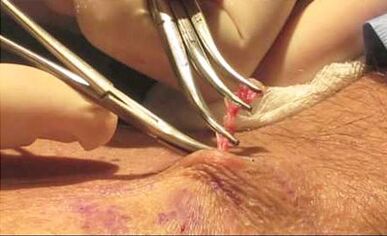
Normally, about 30% of the blood from the lower extremities flows through small subcutaneous venous tributaries, which connect into two central vein trunks - large and small subcutaneous veins.These containers are directly related to deep veins, through which 70% of blood.In the places of such compounds there are valves that pass only from surface veins in deep.There are also dozens of small veins, additionally connecting a surface wedding net with a deep.They also have valves that pass the blood in just one way.The main cause of varicose veins is the failure of the fan, which leads to improper blood release: from deep veins to the surface, which increases the pressure in them and leads to spread and small vessels and central meats.The main goals for which surgical treatment is focused on varicose veins of the lower extremities:
- Elimination of blood stagnation in modified surface veins of the legs, which will prevent the progress of chronic venous insufficiency and trophic skin disorders.
- Removing deformed vessels and varieties representing a cosmetic disadvantage.
- Elimination of blood release from deep veins in the surface - bay and intersection of perforental (clans) vein, as well as large and small subcutaneous veins in their relationship with deep.
- Prevention of repeated occurrence of varicose veins.
A separate place in the surgical treatment of female varicose veins of the lower extremities belongs to cosmetic surgery.After such interventions, not only pathologically modified veins, but also postoperative scars on the skin of the leg or are inconspicuous.To achieve maximum cosmetic effect, surgical operation for varicose veins is performed according to the following methods:
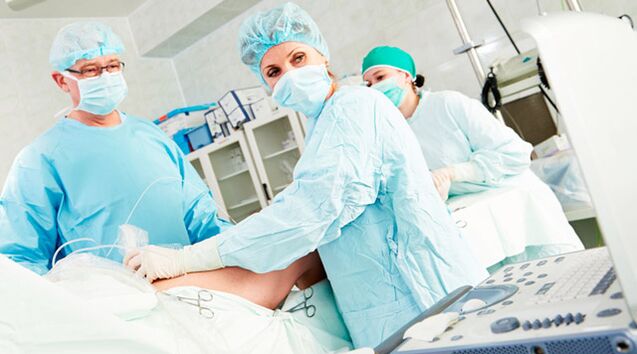
- Laser or radio frequency ablation Vena-Ignition of central trunks of large and small subcutaneous veins under ultrasound control through the piercing skin on the thigh or foot.
- Stem scleroclation and sclerotherapy - filling large and small subcutaneous veins as well as all their tributaries, even at least, with a special medicine.
With any of the described treatment methods, varicose veins are not removed, they have already been converted from blood vessels in a soft cicatričak fabric.And physical influences (laser rays, radio frequency waves) and chemical compounds (sclerose) destroy the inner layer of veins.Thanks to that, losing lumen, glue and completely lowered blood, turning into a regular bonding (cicatric) tissue.Therefore, without direct vein removal, all goals are achieved, which are awarded quickly treatment of varicose veins of the lower extremities - changed vessels are eliminated, and the dangerous consequences of venous insufficiency are eliminated in them.The only limitation of cosmetic surgeries in the treatment of varicose veins in women is possible only something or limited extended veins per 1-2 degrees.During the pregnancy and in the early post perpetration, surgical treatment was contraindicated with the exception of acute situations that require urgent intervention, for example, with an upward thromboflebitis.The operation is limited to the overflow of a large subcutaneous vein at the point of connection with the Fed (window layer).Consider the most common surgical interventions in the treatment of varicose veins of the lower extremities: laser ablation, endoscopic vein and phlebectomy dissection.The latter is divided into the following types:

- Classic surgery or complete removal or operation of Trojan-Trendelenburg-Bubko-Narata;
- short removal;
- Flebectomy.
Flebectomy
Removal, extraction of veins from the skin is called phlebectomy.This is one of the first methods of surgical treatment of varicose veins of the lower extremities.But even today, phlebectomy is most often performed with phlebology and vascular surgery.There are three modifications and work methods: full, short download, miniflex.Domestic surgeons call classic phlebectomy surgery Trojan-Trendelenburg-Bubko-Narat and foreign authors with full removal.The amount of intervention is presented:
- As a bandage of the trunk of a large subcutaneous vein in the place of his mouth, 2-3 cm on the thigh under the inguinal flap, in thigh, through the cut.
- Its removal throughout the groin to the leg using a special probe through two skin cuts 1-2 cm along the inner surface near the knee and ankle.
- The removal of all varicose veins and small veins through separate small cutting is about 1-2 cm (can be 5-6 to 10-20) with the overflow of insolvent perforate vessels.
- Sewing all the wounds of cosmetic seams.
Classic phlebectomy is the most common allows you to remove varicose veins, but most traumatic among all existing techniques.
Brief removal
With a short skiing, the whole large subcutaneous vein is not removed, but only his fragments, for example, affected by varicose veins, only on thigh or on the lower leg.Healthy segments are not removed.This reduces the trauma of the intervention, but the risk of recurrence of the disease remains.Otherwise, operational operations operations are similar to classical phlebectomy.
Flebectomy
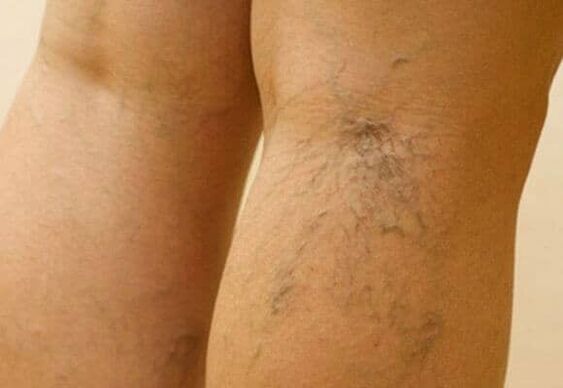
An innovative methodology for removing small varicose veins of large subcutaneous veins is called phlebectomy.For his implementation, special tools are needed (pointed scalpel, hooks, clamps, blades), with which veins outside pull through the skin skin several millimeters.It is not necessary to sew such skin damage, scars are invisible.The most common surgeons combine a short or complete removal of a large subcutaneous vein with flexomomy.Such a combined operation combines radicalism and adhesive trauma with good cosmetic effect.Laser ablation for varicose veins includes the ignition of the laser beam of large subcutaneous veins throughout its approval.To do this, through the penetration of the skin on the thigh or in the ankle area in Lumen in a vertown, livestock is introduced into the entire length.Under the control of ultrasound, the holy is slowly extracted.Laser beam, which operates on the vein wall, destroys the inner layer.As a result, Vienna falls and stops functioning, which is clearly visible on an ultrasonic monitor.If not only the main venous trunk affects varicose veins, but also its tributaries, they are removed in accordance with the phlebectomy method.
The disease like varicose veins is a disease characterized by the dysfunction of vascular walls and the weakness of valve in the veins, which causes stagnation in the blood vessels of the lower extremities and the appearance of venous nodes.Such pathology is quite dangerous and full of not only with trophic disorders and the presence of the inflammatory process, but also the lack of tissue nutrition.As a rule, it contributes to the formation of blood clots, which through the flow of blood can spread throughout the body and the appearance of difficult to live trophic sores.In addition, the formation of thrombotic formations within the vessel threatens the development of such diseases as thromboflebitis.Therefore, if the patient has varicose veins of the lower extremities, surgical treatment is mandatory, especially if the disease is initiated.I would like to draw the attention of the readers of our site that the operation for varicose veins of the lower extremities is a radical measure and, as a rule is prescribed if it cannot without it.Varicosis of lower extremity disease, surgical treatment includes several, which are most used in surgical treatment options for surgical treatment.These options are directly in access to removing the affected veins and the veins of the lower extremities.
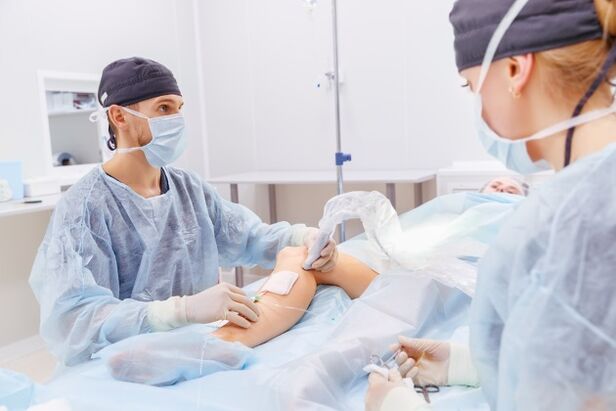
- The use of traditional fleecomia in surgical practice of radical treatment of varicose veins.This option is done in accordance with the Bebbok methodology.This implies the introduction of a probe specifically designed for such proceedings in Lumenica vessels and a later vein extract through a pre-war cut.After surgery, his cable is performed by a cosmetic seam, after that makes it almost invisible.
- Flebectomy - such operation is needed to remove small parts of blood vessels and veins, affected by varicose veins.Note that this operation does not provide for cutting on the skin, as part of the affected vessel or veins remove using the skin break, which does not require the seams.
Note that the surgical intervention in the treatment of certain diseases is shown away.However, varicose veins of the lower extremities, surgical treatment is extremely necessary if the removal of blood clots and potentially dangerous sources of inflammatory process.This approach will improve the patient's condition and help to avoid serious and insecure for the health and life of the patient's complications.States that require urgent surgery for varicose veins include:
- The presence of thrombophlebitis or risks provoking his appearance;
- acute thrombophelbitis or frequent deterioration of the disease;
- An extensive defeat of blood vessels and veins;
- A constantly disturbing feeling of fatigue and severity in legs, unpleasant pain, which indicates clearly expressed varicose veins;
- The occurrence of trophic rectors.
There are also certain contraindications for varicose vein surgery:
- Second and third trimester of pregnancy;
- the presence of infectious diseases in acute form;
- deterioration pathologies that exist in the patient (diabetes, asthma, peptic ulcer and others);
- Myocardial infarction, stroke;
- Dermatological problems.
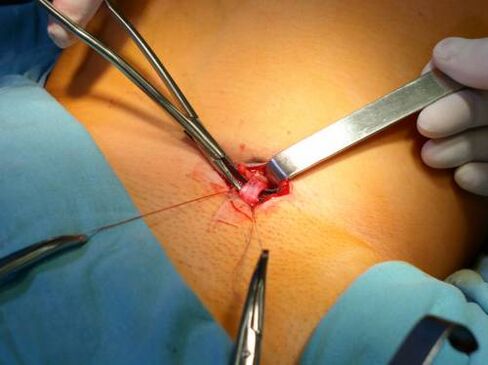
Removing - As a rule, this method is used in the presence of a small part of the lesion, this is a technique that is higher, as opposed to traditional phlebectomy.The method consists in stretching, through a special hook, the most unusual node.There is also a subspecies of this technique - cryotropping, which implies the sinking damaged vessel on cryosond and its later removal.
Sclerosis - technique predicts the introduction of damaged scleros, a special substance for "gluing" walls of the vessel among themselves.However, after the proceedings, it does not extend, but remains in force, without fulfilling its purpose, although the blood passes through Vienna and stops, however, this function is made by collateral vessels, which does not violate the outflow of venous blood.The operation is performed under mandatory control of untrasonic equipment specialists.
Laser coagulation - This method is most innovative in the treatment of varicose veins and is the introduction of special equipment with laser radiation (thin probe) in Lumen.The device has a catering effect on the walls of the blood vessel.
Consequences after surgery for removing varicose veins:
- The occurrence of characteristic postoperative hematomas on the surface of the body, which, as a rule, is resolved several months;
- Also, after a few months, seals under the skin located next to the bed of the remote vein disappear;
- Violations of the integrity of the lymphatic system (blood vessels) of blood vessels, which can lead to standing processes.Such postoperative consequences are treated conservative, however, the lymph circulation is often returned after several months;
- Possible damage to the endings of subcutaneous nerves, which is manifested by the impaired sensitivity of the epidermis-postoperative symptoms passes after 5-6 weeks.
Compression
Varicose disease operations
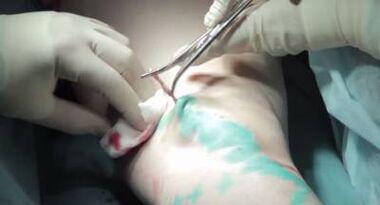
Traditionally, flebectomy (observer) is done according to the Bebcock method and consists in the introduction of a probe in a vein with a later part of the veins completely over its length through the cut on the skin outside.The incision is seamed at the end of the cosmetic seam surgery.Flebectomy is used to remove very short areas of veins, wins are not used during surgery.The skin cuts are not carried out, and a piece of vein is removed by a thin parabody on the skin that does not require imposing seams.With a small surface of varicose veins damage, it is possible to perform a gentle technique - removal.It stretches with a thin hook only a varicose node.Experience is done using two cuts on the skin with their subsequent chess.Different this technique is crionthroping - "sinking" vein in cryosonds using low temperatures, the destructive node is also stretched out.
Vienna sclerosion is the introduction of sclerosant in her lumen - a substance that "beautiful" walls with each other, but the vein remains deep under the skin, not their functions.Blood flow through veins stops and passes through collateral vessels, without violating the outflow of venous blood from the lower limbs.Vienna sclerosis is done under ultrasound control.Laser coagulation of varicose veins is the latest method in flexology and consists in the introduction of a thin probe in Lumen in a vein with laser radiation, which performs the cerealing effect on the walls of the vein.The method of radio frequency output is the vein also relates to more modern treatment of varicose veins, but not all medical facilities are equipped with appropriate equipment.The technique consists in the "cauterization" effect on the vascular wall of the high frequency radio wave.


















